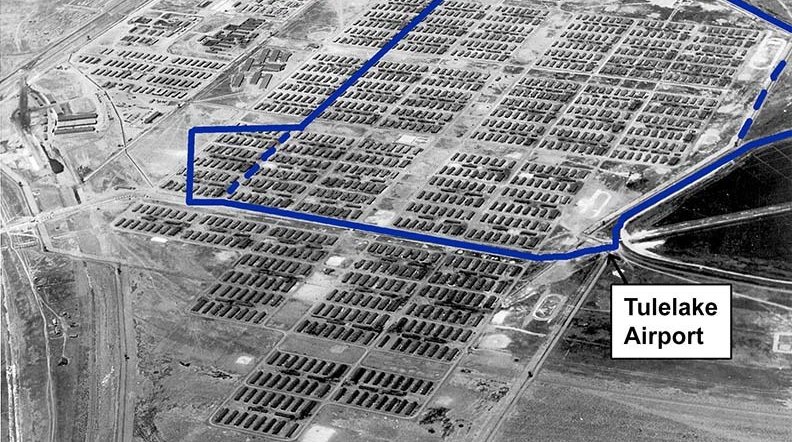
During World War II, 120,000 Japanese and Japanese American civilians — many American citizens by birth — were forcibly imprisoned in hastily-erected American concentration camps (JACL’s Power of Words) located in some of the harshest, most austere, and most isolated parts of the Midwest and West Coast. Enacted through Executive Order 9066, Japanese Americans living on the West Coast were targeted based purely on suspicion that they were disloyal to the US government and posed an existential threat to national security: those suspicions were later shown to be entirely unfounded and predicated primarily on racist stereotypes. WWII incarceration of Japanese Americans remains a major blemish on American history as one of the most prominent violations of American citizens’ constitutional rights, and the government’s rationale for the camps continues to be used to justify anti-Muslim efforts today.
One of the largest and most prominent of the WWII incarceration camps is Tule Lake, a site located in Northern California and currently designated as National Historic Landmark. At its peak, nearly 19,000 Japanese American citizens were forcibly imprisoned at Tule Lake overseen by unusually stringent military guard: the camp had particularly high fences topped with barbed wire and over twenty-five armed guard towers. Tule Lake also became known as a site of particular Japanese American unrest and resistance, and those deemed to be “disloyal” at other camps were removed to Tule Lake for segregation from the rest of the Japanese American community. On November 4, 1943, Tule Lake incarcerees staged one of the few open uprisings against the camps, and on May 24, 1944, Shoichi James Okamoto was shot and killed by a camp guard, who was later fined a dollar for the shooting — a fine for unauthorized use of government property: the bullet. When Tule Lake closed in 1946, thousands of Japanese Americans were once again displaced, with no homes to return to and nowhere else to go.
To remember the painful history of WWII incarceration camps requires that we commemorate the Tule Lake incarceration camp as a site of significant Japanese American WWII-era political and civil resistance. Indeed, the Japanese American community has worked tirelessly to preserve incarceration camp sites across the West Coast and the Midwest, helping to found museums and education centers to teach incarceration history and ensure that the memory of World War II-era camps do not fade with time. Camp survivors also stage annual pilgrimages to camp sites in order to remember this painful episode in our nation’s history.
That is why the Japanese American community is outraged this week at the Federal Aviation Administration (FAA)’s proposed plans to erect an 8-foot tall perimeter fence around the Tulelake Municipal Airport, which would cut through the Tule Lake incarceration camp site and render two-thirds of the Tule Lake camp land inaccessible to camp survivors and students of history.

The FAA claims that the fence is necessary to secure the airport.
The purpose of the fence is to enhance overall airport safety by reducing the opportunity for unauthorized entry of people, vehicles, and wildlife into the aircraft operations area of the airport. The proposed project includes construction of about 16,000 linear feet of 8-foot tall fencing near the perimeter of the airport property.
However, the fence would thoroughly disrupt efforts to use the Tule Lake incarceration camp site as an historical and educational space. Writes community organizer Satsuki Ina, who was born at Tule Lake:
“I am shocked by this insensitive and disrespectful plan. This massive fence will interfere with the desire I and visitors to Tule Lake have — to mourn the unjust imprisonment and to heal the scars of the past. Instead, we will be assaulted with a reminder of rejection, exclusion, and emotional pain.”
The proposed fence may also disrupt land use by local Native tribal nations.
The FAA is currently soliciting the public’s comments on the proposed fence; that period of public commentary will end on October 10th. Ina has created a Change.org petition to try and stop the proposed fence.
As it stands, too few Americans know enough about WWII incarceration camps. We must act now to try and stop this fence, which is an insensitive and unnecessary effort that will only contribute to this nation’s erasure of incarceration camp history. Please take a minute to do the following before October 10th, 5pm PST:
- Sign this Change.org petition.
- Participate in 18MillionRising’s letter-writing campaign to automatically send a letter, or send a letter directly to the Modoc County Road Commissioner, whose office is overseeing the proposed fence plan including the current public scoping commentary period. If you choose to send a letter directly, here’s the contact info:
- Mitch Crosby
Modoc County Road Commissioner
202 West 4th Street
Alturas, CA 96101
(530) 233-6412
mitchcrosby@co.modoc.ca.us - If emailing, use subject line: “TULELAKE AIRPORT PERIMETER FENCE PROJECT”, and cc: savetulelake@gmail.com
- Mitch Crosby
- Share this post widely with your network.
Read More: Descendants of World War II Internees Oppose Proposed Airport Fence on Former Camp (NBC News)
This post was updated on September 29, 2017 with additional details.
